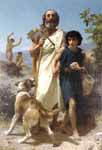Milwaukee Art Museum
Homer and his Guide, William-Adolphe Bouguereau
The Milwaukee Art Museum (MAM) is an art museum located in Milwaukee, Wisconsin with a collection of over 30,000 works of art.
History
Milwaukee Art Museum interior
Beginning around 1872, multiple organizations were founded in order to bring an art gallery to Milwaukee, as the city was still a growing port town with little or no facilities to hold major art exhibitions. Over the span of at least nine years, all attempts to build a major art gallery had failed. Shortly after that year, Alexander Mitchell donated all of her collection into constructing Milwaukee's first permanent art gallery in the city's history.
In 1888, the Milwaukee Art Association was created by a group of German panorama artists and local businessmen. The same year, British-born businessman Frederick Layton built, endowed, and provided artwork for the Layton Art Gallery, now demolished. In 1911, the Milwaukee Art Institute, another building constructed to hold other exhibitions and collections, was completed. The institute was built right next to the Layton Art Gallery.
Milwaukee Art Museum from the south
The Milwaukee Art Museum was Milwaukee's first (disputed, Layton opened that same year) art gallery, opening in 1888.
The Milwaukee Art Center (now the Milwaukee Art Museum) was formed when the Milwaukee Art Institute and Layton Art Gallery merged their collections in 1957 and moved into the newly built Eero Saarinen-designed Milwaukee County War Memorial.
The Reiman Bridge provides pedestrian access to downtown Milwaukee
The 341,000-square-foot (31,700 m2) Museum includes the War Memorial Center (1957) designed by Finnish-American architect Eero Saarinen, the Kahler Building (1975) designed by David Kahler, and the Quadracci Pavilion (2001) created by Spanish architect Santiago Calatrava.
Central vestibule of the Milwaukee Art Museum
The Quadracci Pavilion contains a movable, wing-like brise soleil that opens up for a wingspan of 217 feet (66 m) during the day, folding over the tall, arched structure at night or during inclement weather. The pavilion received the 2004 Outstanding Structure Award from the International Association for Bridge and Structural Engineering.
Collection
The museum houses more than 35,000 works of art housed on four floors, with works from antiquity to the present. Included in the collection are 15th- to 20th-century European and 17th- to 20th-century American paintings, sculpture, prints, drawings, decorative arts, photographs, and folk and self-taught art. Among the best in the collection are the museum's holding of American decorative arts, German Expressionism, folk and Haitian art, and American art after 1960.
The museum holds one of the largest collections of works by Wisconsin native Georgia O'Keeffe. Other artists represented include Gustave Caillebotte, Nardo di Cione, Francisco de Zurbarán, Jean-Honoré Fragonard, Winslow Homer, Auguste Rodin, Edgar Degas, Claude Monet, Henri de Toulouse-Lautrec, Frank Lloyd Wright, Pablo Picasso, Joan Miró, Mark Rothko, Robert Gober, and Andy Warhol.
It also has paintings by these European painters: Francesco Botticini, Antonio Rotta, Jan Swart van Groningen, Ferdinand Bol, Jan van Goyen, Hendrick Van Vliet, Franz von Lenbach ("Bavarian Girl"), Ferdinand Waldmüller ("Interruption"), Carl Spitzweg, Christian Bokelman ("Broken Bank"), Bouguereau, Gerome ("2 Majesties"), Gustave Caillebotte, Camille Pissarro, Alfred Kowalski ("Winter in Russia"), Jules Bastien-Lepage's "The Wood Gatherer", and Max Pechstein.
Controversy
In June 2015 the museum's display of a work depicting Benedict XVI created outrage among Catholics and others.[1]
See also
Argo, a sculpture on the grounds
The Calling, a sculpture in the Museum's collection on adjacent O'Donnell Park
----
Fine Art Prints | Greeting Cards | Phone Cases | Lifestyle | Face Masks | Men's , Women' Apparel | Home Decor | jigsaw puzzles | Notebooks | Tapestries | ...
----
Artist
A - B - C - D - E - F - G - H - I - J - K - L - M -
N - O - P - Q - R - S - T - U - V - W - X - Y - Z
Retrieved from "http://en.wikipedia.org/"
All text is available under the terms of the GNU Free Documentation License



